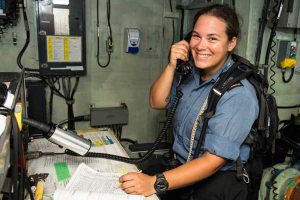Smooth sailing for women in the CAF
By Lookout on Mar 17, 2014 with Comments 0
Life in HMCS Regina has its challenges.
From stormy seas to the daily activities of Operation Artemis (the Canadian Armed Forces (CAF) maritime security operation in the Arabian Sea region) crew members are kept busy.
However, the one challenge not faced by the crew, in particular women aboard Regina, is their gender.
On March 8, Canada celebrated the United Nations International Women’s Day, and one only needed to look at the formidable women onboard Regina to see the accomplishments Canada has made in terms of gender integration in the Royal Canadian Navy, and more widely in the CAF.
The meritocratic system allows women to pursue any role with equal consideration to their male counterparts.
CPO1 Janet Graham-Smith is Regina’s Coxswain. As such, she mentors and provides leadership to crew members of all ranks. She is the highest ranking non-commissioned member on board – a commendable position that is still relatively rare for women. The first female Coxswain of a major warship was CPO1 Jan Davis, appointed 2004.
CPO1 Graham-Smith’s ambition and industrious attitude helped her overcome the challenges faced when she first entered the CAF 33 years ago. At that time, women did not serve on board warships, in the air or in the field.
She felt held back by the limited number of positions she could achieve. Despite that, a 19-year-old Graham-Smith informed her father that she would become a Coxswain in the navy. To which he replied, “That’s impossible, they don’t even let women serve on board ships. How in the world will you ever do that?”
The answer? Dedicated work and progressive changes in policy. He is proud that she and the CAF proved him wrong.
Canada’s developments throughout the mid to late twentieth century have allowed for complete gender integration and equality in the CAF. CPO1 Graham-Smith says, “Nobody looks at me as the ‘female coxswain’; I’m just the coxswain. That’s progress.”
Lt(N) Jana Steingass is a Maritime Surface and Subsurface (MARS) Officer in Regina and says she is recognized for her work, not by her gender.
“I am proud to serve my country, and I happen to be a woman,” says Lt(N) Steingass. “I didn’t join the navy—or army originally—in order to make a political statement. I joined the military for similar reasons as others: to serve my country, to see the world, to make a difference.”
The adventurous decision to try something new led to an exciting role that includes driving the ship, acting as representative for the Commanding Officer, and assisting the Navigating Officer. She is also a member of the ship’s dive team.
Capt Chelsey Ann Llewellyn, a Maritime Helicopter Crew Commander, has a background in biochemistry but fell in love with flying during a summer job with the British Columbia Ministry of Forestry. Encouraged by her family, she followed her passion and joined the CAF as a pilot in 2006.
Capt Llewellyn has an appreciation for the women who paved the road towards an equal space “by establishing successful careers within the military… as well as the men who opened up their hearts and minds in the early days to train those women who showed up ready to learn and serve.”
Women were first selected to be pilots in 1979.
LS Rebecca Charlesworth is a boatswain in Regina. Her work environment is heavily team based and includes activities such as leading exercises on the secure handling of firearms, man overboard recoveries, and the safe and effective transport of personnel or equipment.
In her 12 years of service, she has seen perceptions of women evolve past looking at gender to recognizing job performance as the most important metric for evaluation.
In terms of the international aspect, LS Charlesworth says, “In several countries, women in uniform is now becoming a norm… It doesn’t matter what the gender is, the question is can that member effectively carry out the task given to them by their command.”
Abilities, commitment and effort – rather than chromosomes – determine success she says.
The physical aspect of working in the CAF can sometimes be difficult, but women have risen to the challenge. “It’s about body mechanics and using the right equipment properly,” says LS Charlesworth.
Women’s advancement in the CAF was achieved through the collaborative efforts of both sexes; it grew from the combination of the strong women who persevered and the male allies who accepted them into their teams and who continue to foster an inclusive atmosphere.
Worldwide, women are gaining strength in military positions and are being recognized for their full capabilities.
-Lucy Ellis, CJOC
Filed Under: Top Stories
About the Author:






